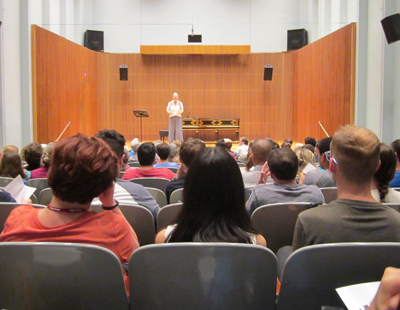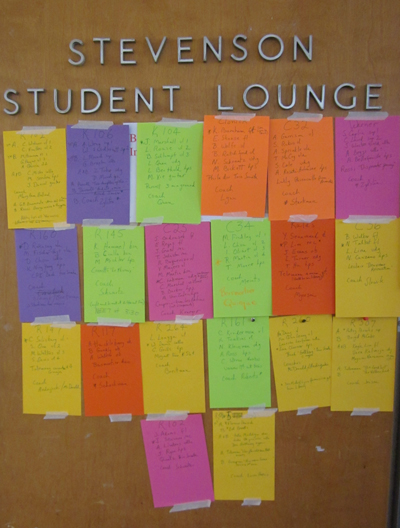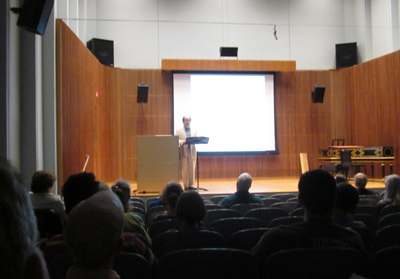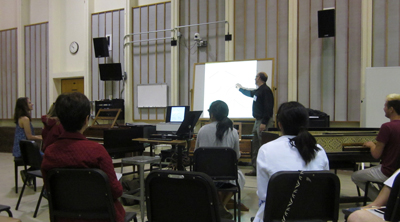by Daniel Hathaway

During a roll call, faculty members sorted out details particular to their students. ‘Need to borrow a baroque bassoon? We can loan you one.’ (‘Or at least part of a bassoon,’ quipped another teacher.) And BPI director Kenneth Slowik urged students, who range in age from high school to octogenarians, to make the most of the experience by venturing out of their comfort zone to try other instruments or disciplines — an opportunity you wouldn’t be offered at most other summer music camps.
After questions were fielded by gambist Catharina Meints, a founder who is now in her 46th year with the Institute, the hall quickly emptied out as students queued to sign up for 5-minute audition slots. Those short interviews would give the faculty enough of an assessment of abilities to create twenty ensembles, an exercise accomplished during what must have been a crazy 90-minute session on Monday morning. By noon, the results were colorfully posted on BPI’s central messaging system, a huge bulletin board in the Con Lounge.
For me, Monday’s activities included the first set of harpsichord master classes, an entertaining lecture on “Traveling with our Forebears” by Oberlin musicologist Steven Plank, a coached ensemble rehearsal, and an evening continuo lab.
Lisa Goode Crawford, Mark Edwards, and Mitzi Meyerson gave fascinating feedback to three students during the noontime harpsichord master class (more about those sessions on Tuesday).
Plank, speaking to BPI’s topic of the summer, “Traveling Through the Baroque 1650-1750,” reminded us that travel has always been an experience, whether accomplished slowly (in the old days by horse-drawn carriage) or at warp speed (until recently, via the Concorde). Although some things have gotten easier, many have not. And the personalities of those who took The Grand Tour in the 18th century — ranging from difficult-to-please British matrons to see-it-all-in-a-day tourists like Horace Walpole — aren’t unknown among today’s Eurail pass holders.
My ensemble assignment for the week involves two singers, an oboist, and a cellist — we’ll work up arias by Georg Philipp Telemann and Christoph Graupner under the tutelage of lutenist Lucas Harris. It’s the Institute’s policy to leave the participants to their own devices for the first session, with coachings to begin on Tuesday. The first runthrough (I’m playing organ continuo) went smoothly enough, but my compatriots — who have done this before — assured me that what seemed in good shape on Monday will be taken to pieces by the middle of the week and hopefully reassembled in time for Saturday afternoon’s student concert.
Joseph Gascho is in charge of teaching the art of continuo playing as well as conducting the BPI student orchestra. From Monday through Thursday evening each week, an 8:00-10:00 pm continuo class delves into the thorny subject of realizing Baroque composers’ harmonies from a bass line fitted out with numbers indicating what pitches are to be played by the keyboard player. Gascho — who leavens his scholarship with boisterous humor — set up four harpsichords and took students through various exercises using the bass line of the famous Pachelbel Canon to generate interesting and well-behaved musical textures.
He also demonstrated “Partifi,” a cybertool invented by an Oberlin graduate that was designed to digitally extracts parts from a full score. Gascho likes to use it to strip the chords modern editors have helpfully written out, but which inhibit the imagination of keyboard players. In line with BPI’s policy to use only figured basses, he sent everyone who’s playing in an ensemble home to purge their scores.
Published on ClevelandClassical.com June 20, 2017.
Click here for a printable copy of this article







